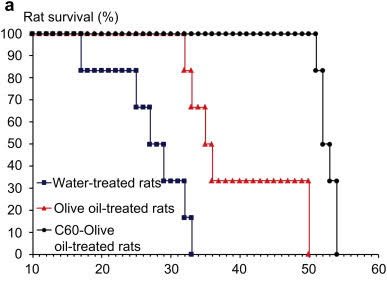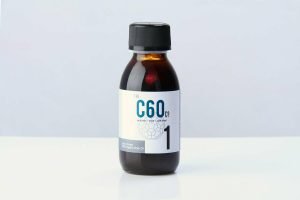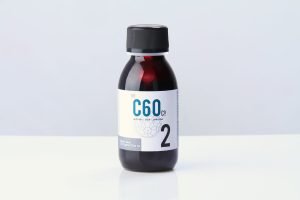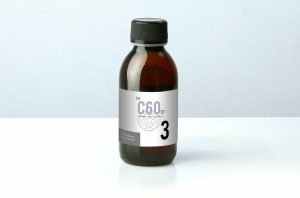Research
Het oorspronkelijke onderzoek dat de belangstelling voor Carbon 60 Olijfolie heeft gewekt.
The Prolongation of the Lifespan of Rats by Repeated Oral Administration of [60]Fullerene
(also known as The University of Paris Study or The Baati Study)
Biomaterials, Volume 33, Issue 19, June 2012, Pages 4936-4946. Available Online 10 April 2012
Tarek Baati, Fanchon Bourasset, Najla Gharbi, Leila Njim, Manef Abderrabba, Abdelhamid Kerkeni, Henri Szwarc, and Fathi Moussa “Abstract: Countless studies showed that [60]fullerene (C60) and derivatives could have many potential biomedical applications. However, while several independent research groups showed that C60 has no acute or sub-acute toxicity in various experimental models, more than 25 years after its discovery the in vivo fate and the chronic effects of this fullerene remain unknown. If the potential of C60 and derivatives in the biomedical field have to be fulfilled these issues must be addressed. Here we show that oral administration of C60 dissolved in olive oil (0.8 mg/ml) at reiterated doses (1.7 mg/kg of body weight) to rats not only does not entail chronic toxicity but it almost doubles their lifespan. The effects of C60-olive oil solutions in an experimental model of CCl4 intoxication in rat strongly suggest that the effect on lifespan is mainly due to the attenuation of age-associated increases in oxidative stress. Pharmacokinetic studies show that dissolved C60 is absorbed by the gastro-intestinal tract and eliminated in a few tens of hours. These results of importance in the fields of medicine and toxicology should open the way for the many possible -and waited for- biomedical applications of C60 including cancer therapy, neurodegenerative disorders, and ageing.”
Full study available for rent or purchase here:
Charts associated with this study are linked below. Authors of the above paper have issued several corrections, most notably a correction to the survival chart, figure 3. These charts reflect the corrected data:
Corrigendum to “The prolongation of the lifespan of rats by repeated oral administration of [60]fullerene” [Biomaterials 33 (2012) 4936–4946]
Author links open overlay panel https://doi.org/10.1016/j.biomaterials.2012.05.023
Refers to
Tarek Baati, Fanchon Bourasset, Najla Gharbi, Leila Njim, Manef Abderrabba, Abdelhamid Kerkeni, Henri Szwarc, Fathi Moussa
Biomaterials, Volume 33, Issue 19, June 2012, Pages 4936-4946
Subsequent to publication of this paper online the authors have realized that there were errors in two figures, Figures 3 and 4. The correct figures are given below. The authors apologize to
readers for these errors.
Editor’s Note
It should be noted that one of these errors, referring to the inadvertent duplication of the same image within two panels of Fig 4, was pointed out to the Editor-in-Chief by several readers. The authors contacted the Editor-in-Chief with an explanation of this error and an error in Figure 3 before he requested an explanation from the authors. This paper draws conclusions that appear counter-intuitive. The Editor-in-Chief received two very detailed reports from referees who indicated that the methodology appeared sound and they both recommended acceptance after some revision. Neither referee nor the Editor-in-Chief noticed either error, and the revised paper was published. Due consideration has been given to the potential effect of these errors on the overall results and conclusions drawn, and so it has been decided the conclusions are still valid. The authors have provided explanations of how the errors were made during the preparation of graphics and images.
Een ander onderzoek die de antioxidant eigenschappen van Carbon 60 onderzocht:
Possible Mechanisms of Fullerene C60 Antioxidant Action
Biomed Research International. Published online 2013 Oct 8.
V. A. Chistyakov, Yu. O. Smirnova, E. V. Prazdnova, and A. V. Soldatov
“Abstract: Novel mechanism of antioxidant activity of buckminsterfullerene C60 based on protons absorbing and mild uncoupling of mitochondrial respiration and phosphorylation was postulated. In the present study we confirm this hypothesis using computer modeling based on Density Functional Theory. Fullerene’s geroprotective activity is sufficiently higher than those of the most powerful reactive oxygen species scavengers. We propose here that C60 has an ability to acquire positive charge by absorbing inside several protons and this complex could penetrate into mitochondria. Such a process allows for mild uncoupling of respiration and phosphorylation. This, in turn, leads to the decrease in ROS production.”
Full study available here:
HEEFT U EEN VRAAG?
Stuur ons een e-mail aan service@c60oliveoil.nl en we zullen met u in contact treden. Wij zijn bereikbaar van 10:00 – 16:00 uur.






